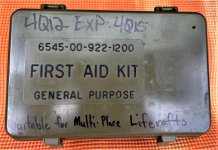- Joined
- Feb 25, 2014
- Messages
- 1,649
- Reaction score
- 3,140
Wasn't sure where to put this but figured it does fall under the realm of self defense.
I am looking at putting together an emergency first aid kit geared toward gunshot victims.
I plan to have it available in my range bag when I go to the range but also have available in the event of an active shooter type situation.
I am no longer on active LE status but figure it can't hurt to be prepared.
I am looking for suggestions from others of items they may have in a similar set up if you have one.
Keep in mind this will be a small portable kit suitable to carry on your belt.
Thanks for your input.
I am looking at putting together an emergency first aid kit geared toward gunshot victims.
I plan to have it available in my range bag when I go to the range but also have available in the event of an active shooter type situation.
I am no longer on active LE status but figure it can't hurt to be prepared.
I am looking for suggestions from others of items they may have in a similar set up if you have one.
Keep in mind this will be a small portable kit suitable to carry on your belt.
Thanks for your input.


